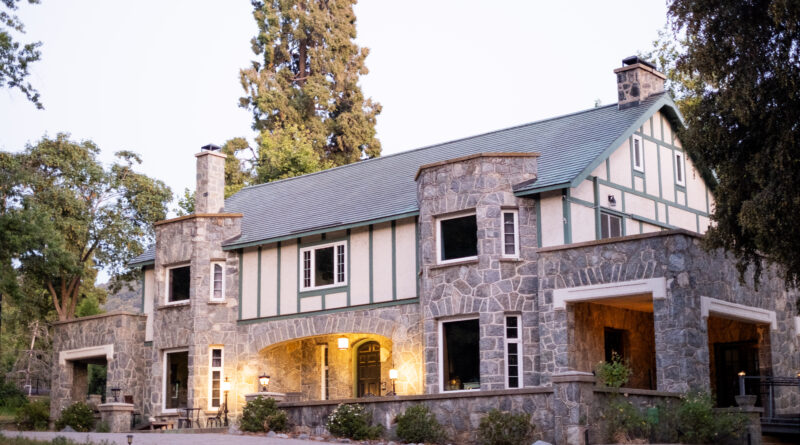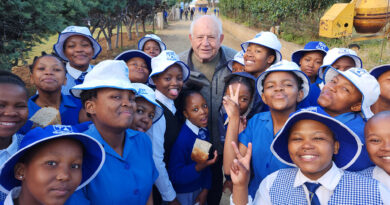Welcome to Oak Glen
This past spring, as the calendar approached May, my phone rang. It was my sister.
Without saying hello, she started, “Hey, what are we doing for mom and dad’s anniversary? . . . It’s their 60th you know.”
I didn’t know. In fact, I’m horrible with dates. What I did know was that “doing” would involve travel rather a wrapped gift.
“Time with my family,” my mother always says. “That’s all I want.”
Easier said than done, since that includes six adults and three teenagers, all of whom web in nine directions. And so, the brainstorming began. My sister suggested several feasible destinations close enough to San Diego but far enough from home.
Over the years, we’ve bonded in Baja, bundled in Big Bear, hiked in Idyllwild, skied in Mammoth, and sailed to Catalina. Each trip better than the last, has been locked in our minds as a family keepsake. Oddly enough, I have this fear that returning to any of those destinations might blanch those vibrant memories.
That’s when I suggested Oak Glen, to which my family responded, “Oakland? What’s in Oakland?”
Say it too fast, and others might ask the same. At the foothills of the San Bernadino Mountains, Oak Glen is 1.5 hours from Los Angeles, less than 3 hours from San Diego, and just over 1 hour from Big Bear. The proximity made it an easy sell for my family, as did the pre-trip research of hiking trails, pie shops, and an entire “hotel” to ourselves.
A text thread locked in the dates of July 4th weekend, with clapping and heart emojis to confirm our joy. Soon we were on our way to the agricultural community where giant wooden apple cutouts beckoned with the words, “Welcome to Oak Glen.” From Interstate 10, the most scenic option is to enter at Beaumont before Cherry Valley, and then exit through Yucaipa forming a 20-mile loop.
At the core of this pretty little circuit is the 5-mile apple avenue, Oak Glen. It feels more like a road-of-surprises than a town, where farmers, artisans, eateries, and family-owned businesses all point back to apples.
Although we were visiting in summer, rumor had it we could still pluck from the heavy branches. Perched at nearly 5,000 feet, Oak Glen’s summer weather teeters somewhere in the 80’s. Our weekend peaked at 103. Palming the hot air with my hand, I quickly rolled up the window and turned toward my mother who was pointing out landmarks to no one in particular.
There were pie shops, church camps, and historical sites including Oak Glen School House Museum, and Edward-Dean Museum with a collection of 16th-20th century works.
We arrived three hours before the rest of the family, capitalizing on the early check-in at our lodging of choice, Stone Oak Manor.
Dating back to 1924, the manor—originally named the Baumann House—was built on a stroke of luck . . . or on oil, as history would have it. As a teacher in Long Beach, Samuel Baumann struck liquid gold at his two-acre property in Signal Hill. The profits funded 300 acres in Oak Glen, a destination he chose after purchasing an Oak Glen apple from a child at the train station. In true Garden of Eden fashion, Baumann took a bite of the crisp fruit and immediately invested in Oak Glen’s fertile land.
One of Baumann’s students—Reginald Inwood—begged to design his professor’s new home. This first structure would catapult his career as a famed architect in Long Beach. There was nothing simple about those blueprints, demanding a manor built entirely from hand-cut boulders gathered by horse and carriage.
In 1926, the stone house was finally finished, and 100 years later, I got to stay there. Thanks to Baumann, the manor had electricity, as did the entire mountain town. The mogul was instrumental in putting Oak Glen on the map by supplying power, establishing roads, and rebuilding a one-room schoolhouse that still stands today.
From the early Cahuilla and Serrano tribes to Samuel Baumann, they all recognized Oak Glen’s potential in the forests, wildlife, and year-round streams. Even before Baumann, it was Enoch Kidder Parrish who became the area’s first apple grower in 1860, followed by Joseph Wilshire in 1877. Other famed farmers include Isaac Ford, and later the Rivers brothers who bought Los Rios Ranch, earning it the title as Southern California’s largest apple farm.
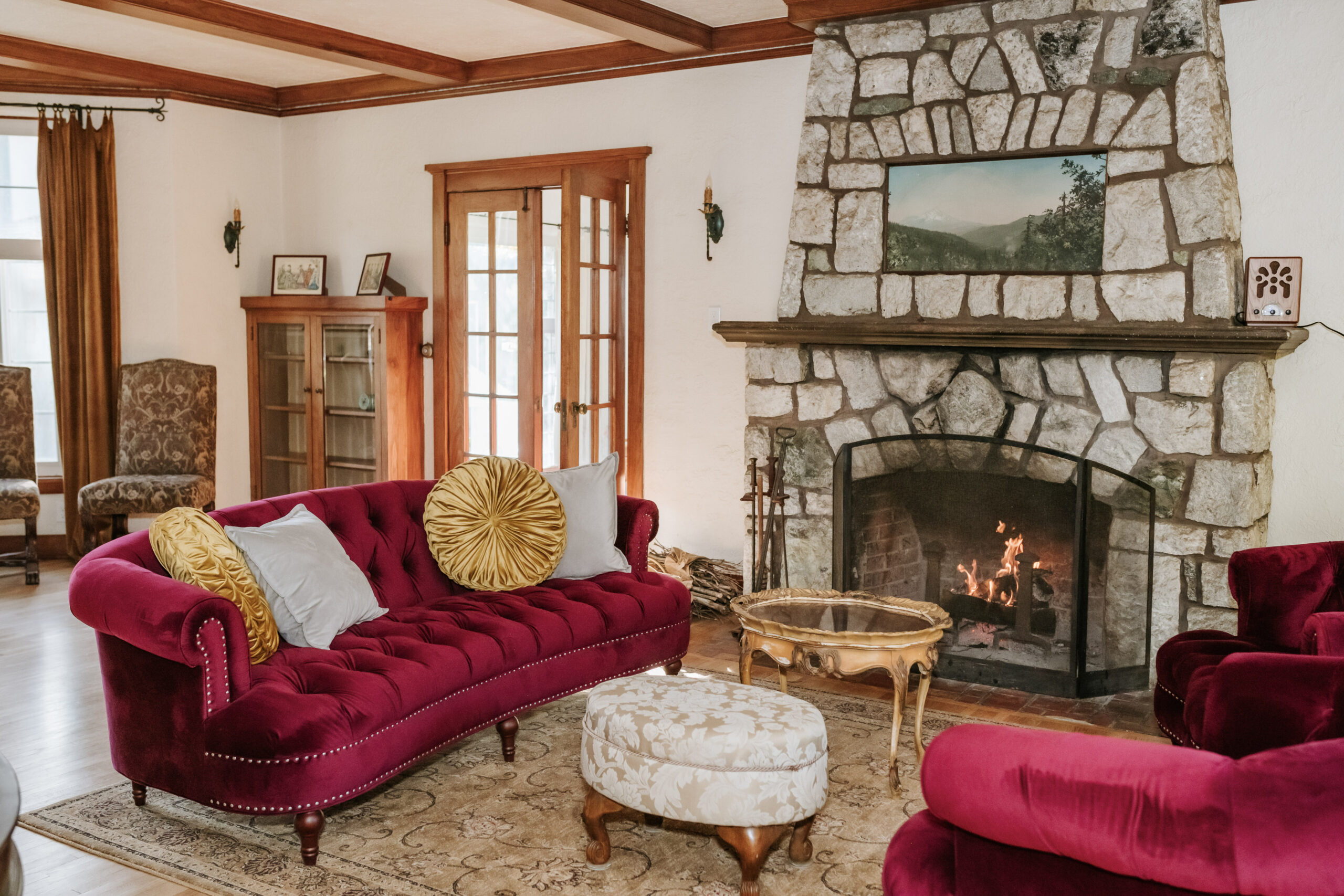
Three generations of the Baumann family kept tradition not only by growing apples, but by inviting the community to the manor for their July 4th picnic. Community has always been a pillar of Stone Oak Manor. In 2019, current owners, Kirsten and Tim, were seeking a wedding venue to host their big day. Based in Berkeley, they purchased the manor to host their Dungeons and Dragons-themed wedding on Halloween 2021. This would be the first of many non-traditional weddings they hosted with onsite accommodations.
Like most love stories, the manor’s honeymoon phase was threatened by the pandemic, flooding, mudslides, and the El Dorado Fire that ignited during a gender reveal party. Despite the heat, the couple kept their cool by registering the wedding venue as a bed and breakfast.
Available by the room from $100, or by the entire 10-bedroom house from $1,000, our family chose that latter. This gave us access to a fully equipped kitchen, an elegant dining room, and plenty of outdoor space on two gated acres. There was even an attic dedicated to entertainment with boardgames, books, foosball, and videogames. Murphy beds and extra roll-aways could comfortably sleep 20 guests.
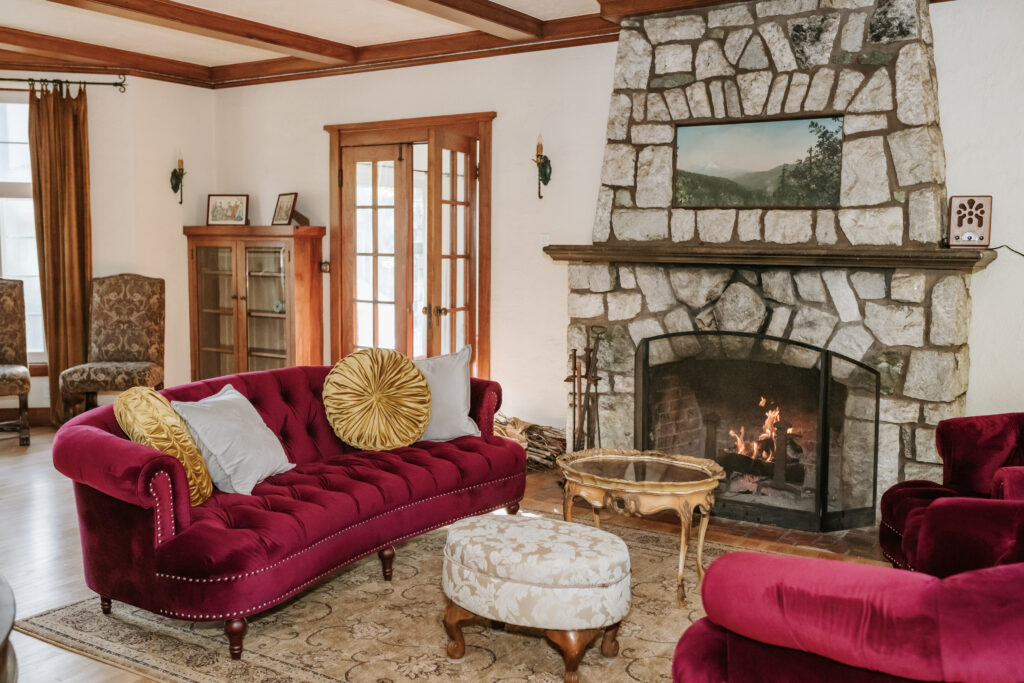
The nine of us cherry picked the coziest of suites with poster beds and private balconies, and then connected in the parlor for games and in the sunroom for conversations. If only we had known there was a serious one on the horizon.
That evening, we cooked dinner as a family, laughing over my mother’s surprising ability to land a beanbag at corn hole, and my father’s unexpired talent at the organ. Among antiques in the manor was an organ passed down from Kirsten’s great grandmother in Virginia. It didn’t work, as she pointed out when my dad floored the pedal like an accelerator. Growing up, we had an organ in our home that my dad fumbled across, singing hymns off key while I spun pirouettes behind him.
Some 40 years later, those ballerina twirls were now towel slaps at my nephew’s thigh who just returned from college.
“Doesn’t hurt,” he said with an eye roll. My husband grabbed the towel and twisted it into a tight cylinder.
“Let me show you how it’s done,” he said, with confidence.
My nephew went running; my sister hollered that dinner was ready; my niece unfolded her napkin; my brother-in-law removed his hat to say grace; and my mom clapped, as if catching that moment in the air between her palms.
As always, my dad sat at the head, not saying much until the end of the meal. “I have cancer,” he blurted. “The doctor says it’s aggressive, but I can keep landscaping to raise money for kids in Africa.”
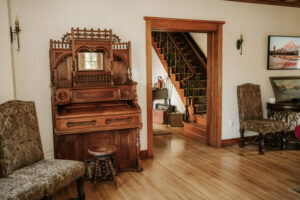
Our forks dropped and the floodgates of emotions opened, some in shock, most of us crying, and my husband angry that my dad didn’t know the meaning of selfcare. Their entire lives, my parents had humbly sacrificed their own needs to serve others.
While none of us had answers, we had plenty of questions to pour on the table. My mom slapped both hands on her lap, “I feel this weekend was ordained as part of the preparation journey.”
“Well, I feel like we need to go hiking,” I said. My comment was poorly timed. “Let’s get dad healthy. Cling to today, and hope for tomorrow, right?!”
I didn’t know what else to say. I might as well have been spinning pirouettes behind him. But onward we went, hiking bright and early at The Wildland’s Conservancy. This 909-acre Oak Glen Preserve took our minds off reality as we trailed streams beneath canopies of oaks, willows, and sequoias.
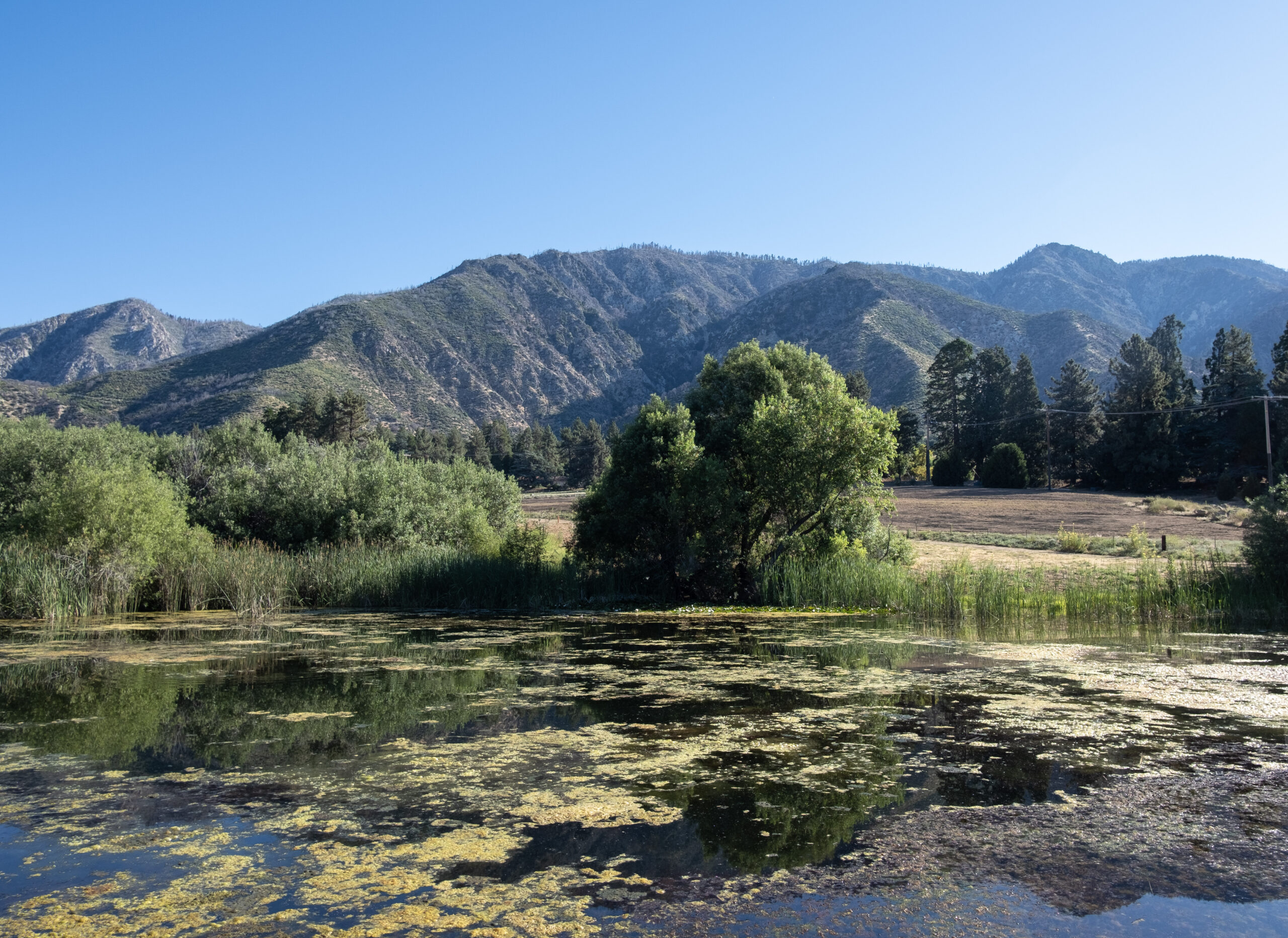
In 1996, The Conservancy saved Southern California’s largest historic apple ranch from residential development. It also acquired thousands of acres to protect the San Bernardino National Forest.
“Could we rest a bit?” my mother asked.
My parents sat down on the floating dock at Red-Wing Pond. My brother-in-law pointed toward a turtle, as I watched dragonflies kiss the water. It was there that the nostalgic sound of a church bell rang in the distance. Tears streamed beneath my mom’s sunglasses, as she whispered, “Thank you.”
Her faith was strong. My heart was weak. I emotionally changed the subject.
“Let’s go to the Colonial Faire.”
Hosted at Riley’s Farm, the working apple orchard doubles as a living-history farm with dinner theater and educational reenactments. Depending on the season, guests can pick apples, pears, berries, flowers, corn, cherries, peaches, and pumpkins. As luck had it, we were there on the exact weekend of the interactive cultural event honoring American colonies of the 18th century.
“They must be sweltering in all that wool,” my nephew whispered. “Can you imagine having to play the baroque flute in this heat?”
“Or churn butter,” my niece added.
The thespians were on point in the replica New England village, complete with colonial crafts like candle dipping, floral crowns, and woodworking. In the center were dramatic presentations with drumming and dueling.
My dad peeked into the demonstration kitchen where two maidens kneaded dough.
“Where are you from?” he asked.
In a perfect British accent, one responded. “My husband and I are settlers from England.”
“She’s lying David,” my husband said. “She has to stay in character. She’s probably from Riverside.”
With muskets firing in the background, I put my hand on their shoulders and suggested we move on to hard-cider tasting. Around the bend was Wilshire’s Apple Shed, the area’s first roadside stand, now comprised of a café, mercantile, and a 1936 boxcar cigar lounge. We cooled off with ice coffees and hard cider from the attached tasting room, eventually making our way to the wrap-around porch for the breeze.
Despite the cloud of news hovering above us, we stopped midway at Oak Tree Mountain, a 14-acre family-fun park with a petting zoo, restaurants, bars, shops, axe throwing, and bakery with 5lb pies. The smell of waffle cones, chocolate, and caramel wafted from the candy shop and creamery.
It felt like a ghost town, to the point I asked an employee how they survived. He explained that come fall, expect long lines, especially September through October at the height of apple-picking season. Over half a dozen farms offered everything from U-Pick events and apple-cider doughnuts to corn mazes and cider pressing. It all culminates at the Apple Butter Festival during Thanksgiving weekend.
I glanced at my dad, still inhaling the sweet air. “Let’s go back to the manor and watch the Euro Cup,” my husband suggested. Our new normal would involve weaning my dad off of sugar and carbs. Just before reaching the manor, we pulled into Mom’s Country Orchards, a giftshop with souvenirs, breads, jams, honey, fruit butters, and locally-grown apples.
An elderly gentleman held an outstretched apple sliver. “Would you like to try a Pink Lady?”
I did. It was crisp, sweet, and crunchy.
“Dad, you’ve got to try this!” More than ever, I wanted my father to find joy in the small things. The apples were good, well great in fact, and one of several varieties along with Gala, Honey Crisp, and Red Delicious. Displayed among the preserves were antiques, soaps, and breads.
That evening, we dined at Oak Glen Steakhouse across the street from Stone Oak Manor. In 2014, owners Rick and Lori Knudsen won the $180 million lottery and invested their loot into the restaurant. In 2022, it took a brutal hit after a mudslide buried the property in 7-feet of debris. From where we were sitting, none of that was evident. Instead, a pleasant waitstaff offered us complementary dessert on account of my parents’ anniversary.
Closing the menu, my husband told them we would pass, while I explained we were tackling a health issue. It sounded strange, and even more so when the waiter said that he too was watching his weight. This was bigger. Much bigger. It was us, and the potential that our equation would diminish without the mean.
That next morning my dad hugged us all in the crook of his elbows, embracing us in his mighty arms. “We’re going to beat this,” he said. We nodded, hoping he was right.
On that drive home, we rode in silence, my mother sitting with palms upward. I thought of Oak Glen and its humble beginnings—from a kid at a train station, to a lotto winner, to a Berkeley couple who saw beauty in the stones. I thought of the fires and storms Oak Glen survived, yet somehow grew stronger each fall.
I thought of Stone Oak Manor that gave us a place to dance in the kitchen, cry at the table, and remember pirouettes behind organs. I wondered how this Julian-esqe pie town had the power to lure us with apples and unite us in memories amidst the pain.
Though we weren’t yet out of the orchard, we would toil through this season together, knowing that thus far, our harvest was bountiful.

